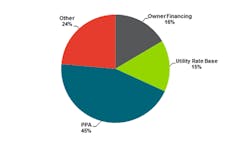Has Hitachi Zeroed In On the Most Viable Microgrid Financing Model?
Peter Asmus, Navigant Research
Peter Asmus of Navigant Research describes cutting-edge work by Hitachi that offers a promising microgrid financing model.
I had the pleasure of participating in an afternoon workshop at the VERGE conference in Santa Clara, California this week. The workshop covered a lot of ground, including offering two different perspectives on microgrids from two leading players: Spirae, a controls and software innovator, and Hitachi, the only company in the world that has declared it has a 100-year-plan for “social innovation businesses,” a broad category of solutions that includes microgrids in North America and Asia.
While the workshop covered a lot of ground, perhaps the most noteworthy portion of the program was a presentation by Urs Gisiger, director of project finance for Hitachi Energy Solutions. Gisiger directly addressed questions that seem to be a hot topic of conversation at nearly every event focusing on the hype and promise surrounding microgrids and a distributed energy future: How do we finance such projects at a time of great market uncertainty? In other words, what is the best microgrid business model?
Credit: Navigant Research
Gisiger set the stage by referring to some recent research performed by Navigant Research, looking at which business models have been deployed in systems in North America in 2015 and 2016. Note from the chart below that if we exclude both remote microgrids and military microgrids—systems with unique investment needs—the overall favorite in terms of business model structure is the power purchase agreement (PPA), representing 45 percent of total capacity.
Of course, a PPA can be financed in several different ways, and this is where Hitachi has really done its homework. In the process, it is shedding light on the part of the microgrid finance supply chain that up until this point in time has largely been in the shadows.
Of course, a PPA can be financed in several different ways, and this is where Hitachi has really done its homework.
Project Financing
For example, Gisiger revealed 20 banks that will do project finance for energy infrastructure today, including microgrids. In addition, he provided a much longer list of 60 banks, the majority of which are selective in their power project financing, that conceivably also loan money for microgrid projects in North America. “In addition, debt funds and insurance companies are also entering the microgrid market,” he said. He also noted that unregulated arms of utilities are also entering the microgrid financing space in North America, a small group creeping up toward 10 at present.
Despite this good news, Gisiger also offered a sobering portrait of financing options, with the majority—including individual project finance and corporate loans—not leading to satisfactory results for either project developer or project owner (or both) today due to high transaction costs. A revolving line of credit for a fleet of projects looks much more promising, since it allows for greater scale.
As an intermediate step to move forward as financiers become more comfortable with the risk profile of microgrids, Gisiger singled out a lease facility arrangement based on full recourse financing on a corporate balance sheet; a line of credit is taken out so no upfront equity is required. The bundling of projects into a portfolio is key to achieve critical mass. This approach results in better overall project economics since portfolio sale proceeds stay with the developer, while significantly trimming overall bank, legal, and advisor fees.
Needless to say, microgrids will never be a one-size-fits-all solution. While utility deployments of microgrids are increasing, it is still third-party microgrids that are plowing new ground, especially in terms of financial innovation, with Hitachi among the leaders.
This blog orginated on Navigant Research’s website and was reposted with permission.
Listen to Peter Asmus discuss microgrids and earthquakes on NPR.
